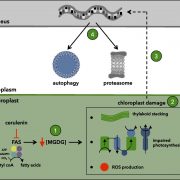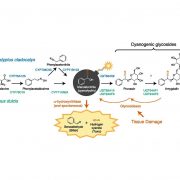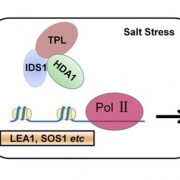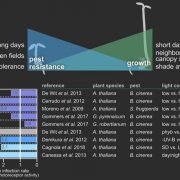
Autophagy and Chloroplast Quality Control: Fatty Acid Synthesis Counts
Plant Physiology, Plant Physiology: News and ViewsPlants devote more than 70% of their available nitrogen to maintaining chloroplast function (Makino and Osmond, 1991). During senescence or under stress conditions, chloroplasts are degraded and their constituent components are recycled. Chloroplasts can be degraded through at least three pathways: (1)…

Autophagy and Chloroplast Quality Control: Fatty Acid Synthesis Counts
Plant Physiology, Plant Physiology: News and ViewsPlants devote more than 70% of their available nitrogen to maintaining chloroplast function (Makino and Osmond, 1991). During senescence or under stress conditions, chloroplasts are degraded and their constituent components are recycled. Chloroplasts can be degraded through at least three pathways: (1)…

Setting and Diffusing the Cyanide Bomb in Plant Defense
Plant Physiology, Plant Physiology: News and ViewsHydrogen cyanide (HCN) is a potent inhibitor of cytochrome c oxidase, a conserved component of the respiratory electron transport chain in all aerobic life. Thus, HCN is well suited to serve as a broad-spectrum chemical defense, and indeed it plays such a role in many interactions between plants and…

Stress Management: OsIDS1 Modulates Histone Deacetylation to Repress Salt Tolerance Genes
Plant Physiology, Plant Physiology: News and ViewsPlants evolved to react to the changing environment by developing sensing and signal transduction mechanisms, which ultimately lead to changes in gene expression and altered plant performance. Transcription factors (TFs) are key to regulating the expression of individual genes. TFs can confer sequence…

Polycomb Group Transcriptional Repressor: Suppress to Sustain
Plant Physiology, Plant Physiology: News and ViewsEvidence of epigenetic gene regulation in plant immunity was first reported in 1975 (Guseinov et al., 1975) with the demonstration that cytosine methylation is altered in response to pathogen infection. Since then, it has been established that pathogen infection influences DNA methylation and histone…

Identification of Woodland Strawberry Gene Coexpression Networks
Plant Physiology, Plant Physiology: News and ViewsWhat we think of as a strawberry is botanically not a berry or even a fruit, but rather multiple fruits (achenes that contain the seeds) on the outside of a swollen receptacle. This technicality aside, strawberries are both economically important and a useful system in which to study seed-fruit communication.…

The Healing Power of Light
Blog, Plant Physiology, Plant Physiology: News and ViewsLight is life, especially for plants. It fuels photosynthesis and, when perceived by photoreceptors, directs important developmental programs, including photomorphogenesis and shade avoidance. Red and blue light wavelengths activate phytochrome (phy) and cryptochrome (cry) photoreceptors, respectively,…

An Improved Tool for Mapping the Membrane-Associated Protein Interactome
Blog, Plant Physiology, Plant Physiology: News and ViewsProtein-protein interactions mediate fundamental biological processes. Yeast two-hybrid assays can be used to detect protein-protein interactions in a fast and large-scale manner. However, in traditional yeast-two hybrid assays, the prey and bait proteins must be located in the nucleus to activate reporter…

Long-Days Enhance Jasmonic Acid-Related Plant Defense
Blog, Plant Physiology, Plant Physiology: News and Views, Plant Physiology: On The InsideDepending on the species, daylength profoundly affects the timing of key developmental transitions in plants, including, floral initiation, tuberization, and bud set and growth cessation in trees. To explore additional effects of daylength on plant function, Cagnola et al. (10.1104/pp.18.00443) investigated…

